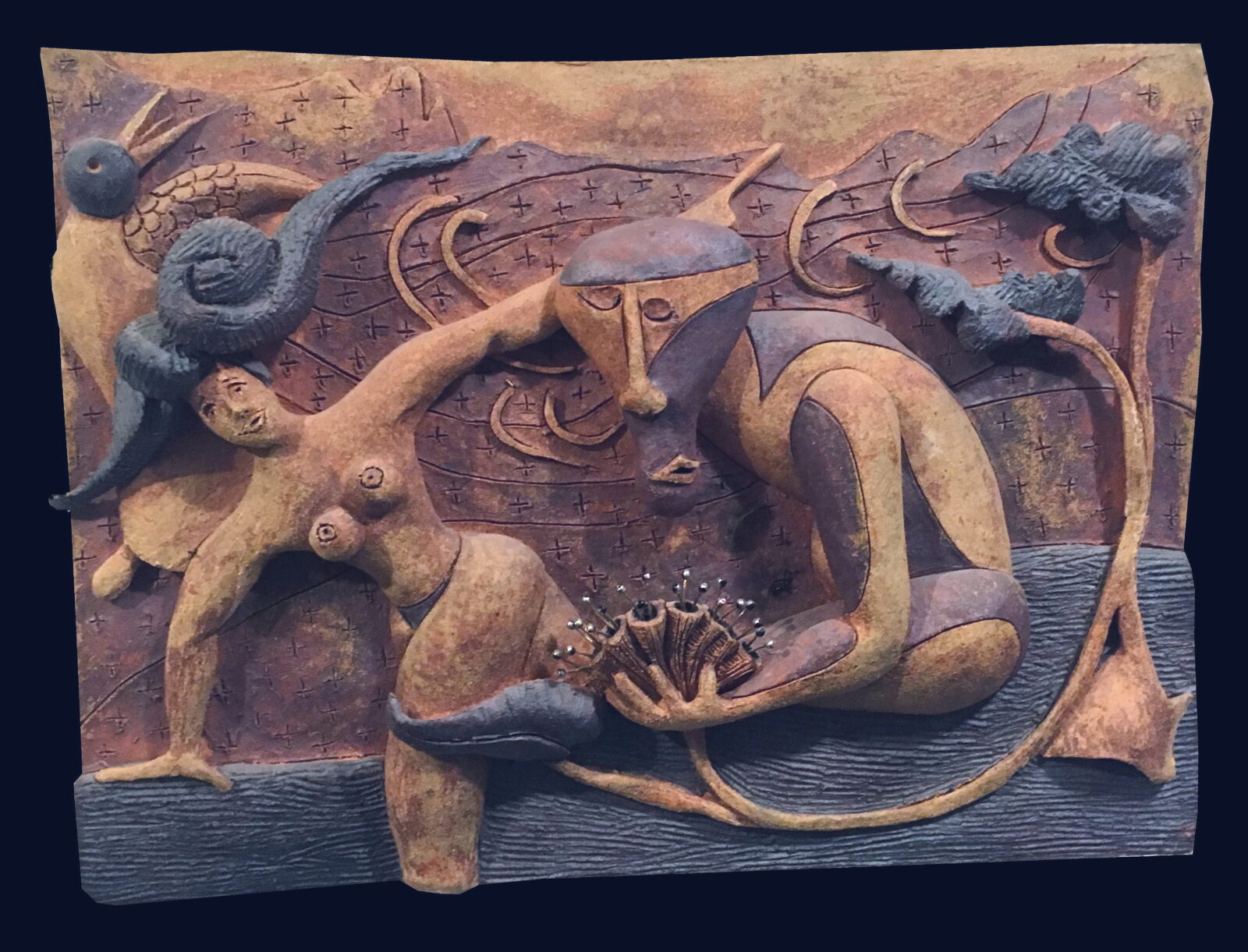Category Archives: Sculpture of the Month
Posted on May 24, 2025 by Brad
I began this May reconnecting with a powerful sculpture from the past. Completed in 2008 & owned by my close friends the Lees, I had forgotten about it until I rediscovered it in my photo archive this month. Although I felt strongly drawn to Dancing Past the Midnight Offering, its deeper meaning wasn’t clear to me! Ultimately, my wife and neighbor helped with some thoughtful insights.

Dancing Past the Midnight Offering
2008
Midnight has often been associated with having visions of or experiencing spiritual transformations. And the central figure in this sculpture seems both mystical and monkey-like. His gesture with the flower reminds me of a Buddhist story…
The Buddha had retreated alone to the forest because his disciples were fighting amongst themselves. There, a monkey offered him honey and then became so excited when the Buddha ate it that he started jumping around in the trees, broke a branch, fell, and died. (Being unable to focus one’s thoughts has often been called the “monkey mind.”) The monkey is ultimately rewarded for his gift of honey, however, when he reincarnates in an enlightened state.
Perhaps the enlightened monkey’s spirit is who we see represented in this sculpture. Instead of honey, he holds a flower of many stamens like a lotus, a symbol of enlightenment. He gazes down on it and appears to blow calmly over the flower as if it were a musical instrument. A spell of empowering energy drifts around him, reaching the naked woman who dances past. She is so empowered, an ecstatic dove appears behind her, cooing with exuberance.
Thus, this sculpture appears to be about moving away from the “monkey mind” that seems to dominate our world right now and toward a more stable, compassionate point of view. The women of the world who mother our children are perhaps best poised to receive such enlightening wisdom and to inspire us all in adhering to calm insight.
Let this message be a blessing for all the mothers! May they inspire you to be calm, wise, and free to express your own natural compassion toward others.
Happy Mother’s Day!
Click Here* to add your comments & name suggestions or see what others have posted for this piece
Posted on May 4, 2025 by Brad
March brings the beginning of spring with the vernal equinox, and the short days of winter begin to lengthen, followed by festivals of fertility and the Christian holiday of Christ’s transcendence at Easter. Nonetheless, I have picked a sculpture to […]
Read more
Posted on May 4, 2025 by Brad
For the February Sculpture of the Month, I would like to express my care for our world by exploring the themes in a sculpture I created and completed during Donald Trump’s first presidency. Doing so will also allow me to […]
Read more
Posted on January 19, 2025 by Brad
We start off this new year with the 50th issue in my Sculpture of the Month series! I began this labor of love with the intention to offer those who appreciate my work some inspiration to (A) dig deeper into […]
Read more
Posted on January 3, 2025 by Brad
In October, I skipped sharing a Sculpture of the Month with you because I had a lot going on! Here in Santa Cruz, I opened the gate to my garden for Open Studios and sold two sculptures, including fan favorite […]
Read more
Posted on November 16, 2024 by Brad
This last month has seen a sea change in our national political climate. It appears the “turning” I mentioned in my last SOM could start bringing a new generation to power soon! With this hope in mind, I’m drawn to […]
Read more
Posted on August 30, 2024 by Brad
It’s good to bring you another Sculpture of the Month today! I skipped July because I had cataract surgery followed by a flurry of local sightseeing adventures with visiting family. But I am back for August! In my last Sculpture […]
Read more
Posted on August 30, 2024 by Brad
For the June Sculpture of the Month, I chose to focus on a piece from my series for “The Fusion of Art and Physics.” I sketched the original drawing for this sculpture in the x-ray microscopy lab of Hendrik Ohldag […]
Read more
Posted on August 30, 2024 by Brad
This month I have chosen to consider a sculpture featuring what appears to be a shocked turtle as the central character with a prescient insect shaman in the background. The Burden of Consciousness Having originated some 230 million years ago, […]
Read more
Posted on April 7, 2024 by Brad
Many of you will notice that my Sculpture of the Month (SOM) email comes late this March… but it also comes early this April! I’ve been buzzing around the county lately, participating in two shows in Watsonville, then setting up […]
Read more




